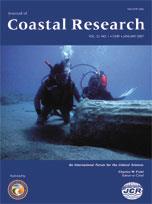Beach erosion, a problem along most sandy shores, can be caused by man-induced interventions to the coast or natural processes. Remediation of beach erosion (i.e., beach restoration) along eroding developed beachfronts is commonly practiced in the United States by periodic beach renourishment with or without coastal structures. Rates of erosion within beach fills generally vary greatly, and areas that erode faster than the nourishment average are commonly termed erosional hot spots (EHSs). Delray Beach, located on the southeast coast of Florida, was renourished for the fourth time on December of 1992 with about 914,000 m3 of sand dredged from offshore and placed along 2.7 km of beach. About 448,000 m3 of the fill had eroded away by 2001, about eight and a half years after initial construction. Two beach segments with erosion rates higher than the nourishment average were identified based on analysis of annual beach profile data. About 40% of the eroded volume accrued from one of these beach segments, a 600-m long EHS located on the downdrift end of the nourishment. We evaluated hypotheses to explain EHS development; these included the influence of nearshore features (reefs and borrows) on nearshore wave propagation, variability of grain size alongshore, and changes in shoreline orientation induced by the placement of fill. The nearshore reefs have little to negligible influence on the nearshore waves and are not the cause of the EHSs. Borrow areas significantly influence nearshore waves along the beach. Grain-size differences alongshore were also not the cause of increased erosion of EHS segments since grain sizes are not persistently finer where higher erosion is observed or vice versa. Change in shoreline orientation in the south end of the fill (EHS segment) causes an acceleration of the alongshore currents and an increase in sediment transport potential. Shoreline orientation effects appear to play a relatively more significant role in the development of the EHS in the south end of the fill than the other processes evaluated.
How to translate text using browser tools
1 January 2007
Processes Controlling Development of Erosional Hot Spots on a Beach Nourishment Project
L. Benedet,
C. W. Finkl,
W. M. Hartog

Journal of Coastal Research
Vol. 2007 • No. 231
January 2007
Vol. 2007 • No. 231
January 2007
alongshore current
Beach morphodynamics
beach nourishment
Delray Beach
erosional hot spot
shoreline change
wave transformation




